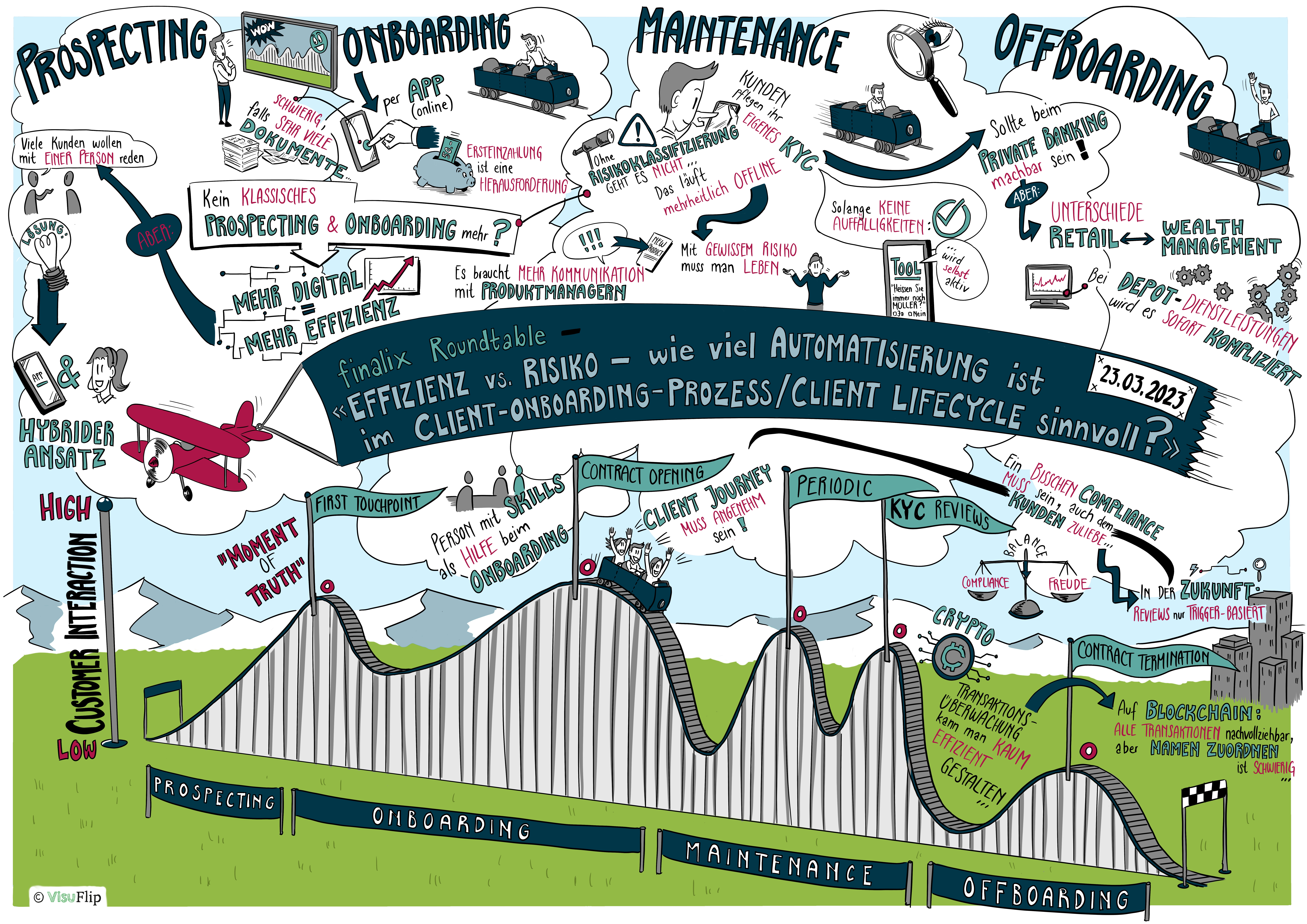On 23 March 2023 finalix hosted its first roundtable in a Client Lifecycle Management and Anti-Money Laundering (AML) context. Participants from across the banking industry in Switzerland contributed to a lively discussion and were asking each other how much automation could be achieved in the process of client onboarding/maintenance while mitigating AML risks. Let us tell you, the results are intriguing.
Banks in Switzerland are under heavy pressure to work as efficiently as possible. One key metric that is often used to measure such efficiency is the number of days needed to onboard new clients. The faster you can turn your prospects into customers, the sooner you will have time to focus on yet another prospect. However, success has many faces. While some banks can get you started with a new account within 5 minutes, others will need sometimes up to 200 days to complete the task. Why is this so?
“Our entire onboarding process is automated. The customer acts completely independently, up to the point where we need further clarifications or information. Then the manual work begins”.
Especially the new contenders – so-called “Neo Banks” or in some cases FinTechs – have made it their primary goal to make the onboarding process as quick and automated as possible. The main reason why this is feasible is standardisation. 80-20 is not enough. Efficiency can only topple risk if there are little to no exceptions to the rule. Thus, these FinTechs focus first and foremost on a very standardised client base. Unfortunately for legacy market participants, these rules cannot be applied to everyone, and the playing field is not always level.
Local regulators propagate the use of a risk-based approach when it comes to AML. The riskier your (potential) client, the more solid your client’s story must be. Seems simple, yet nobody can tell you with certainty what the right approach should look like. Therefore, the bigger the bank, the stricter the rules. Yet, it would be short-sighted to blame everything on regulators.
“The bigger the bank, the stricter the rules”.
To cope with these regulatory requirements and remain efficient, banks have begun experimenting with approaches that focus more closely on the segmentation of their client base. For example, the onboarding process can be differentiated from a full-fledged client self-service for low-risk retail clients, to an accompanied model for the slightly more complex customers to an all-encompassing supported package where clients are guided by an AML/Onboarding specialist.
Furthermore, our participants agreed that the organisation must better reflect this new world in its structure and processes. Product Managers should be aligned with Compliance and must know about the AML implications of any new product. Making products saver against AML risks paves the way to reduce the burden of AML reviews and clarification efforts later. Additionally, some banks strengthened their first line of defence by building up dedicated AML Front Support resources. This frees up time for the relationship managers and places AML knowledge where it is direly needed.
“We aim for an entirely trigger-based review system, where even high-risk clients are only scrutinized repeatedly if circumstances change”.
If automation during onboarding seems restricted to “standard” clients, is there anything that can be done during the ongoing client relationship? With the burden of periodic reviews caused by recent changes in Swiss AML legislation already being felt strongly, the need for good ideas is higher than ever.
Simply put, review cycles depend on the client’s inherent risk. The higher the risk, the more often reviews must happen. In the case of high-risk clients, banks are facing yearly periodic reviews that can easily take up an hour of the relationship manager’s time, but often need much more than that. Conservatively estimated, if you have a client portfolio in a risk market of about 100 clients, you will thus spend at least 12 days per year on reviews.
The buzzwords to improve the situation are data analytics, artificial intelligence, and a few clever algorithms. In one case, the devised risk rating software monitors more than 50 different AML risk attributes to determine the client’s risk rating and review cycle. In addition, client risk is constantly re-assessed to check if any noteworthy events or changes in circumstances occurred. If the relationship’s risk parameters remain constant over time, the actual risk rating decreases.
“If you miss one, you are done!”
This approach sounds very promising in theory, but there is one significant catch. The software is not yet fool-proof and there are still too many false-positives occurring. Given individual criminal liability of bank personnel when faced with clients accused of money-laundering, you do not want to miss even a single bad case. Actual court cases against compliance employees, for example, are rare but not unheard of.
In the end, participants agreed that legislators need to be actively involved in both onboarding and customer review or maintenance, and be familiar with the latest trends in automation capabilities. A standardised approach to risk factors and screening parameters (including structured and harmonised counterparty profiling) across the industry would be even more beneficial.
Is your AML system landscape in need of a revamp? Are you looking for ways to improve efficiency in your client lifecycle management processes? Do you want to take your approach to mitigating risk to the next level?
No matter whether you want to have a smooth journey and user experience from client onboarding to offboarding, or whether you want to properly connect the dots and integrate the AML trifecta of your client risk rating, transaction monitoring and KYC profiling, our experts are happy to support you in your endeavours.
